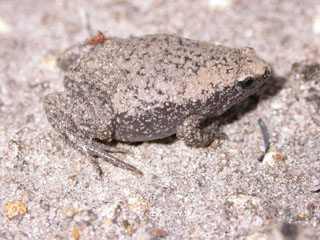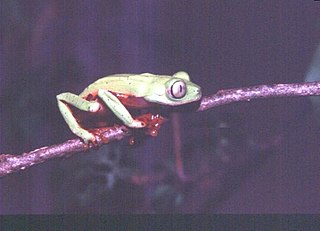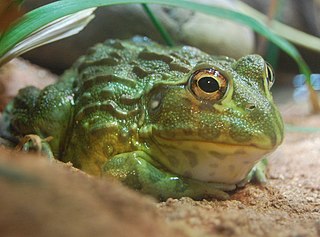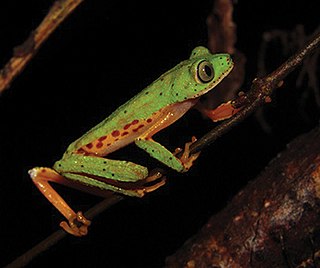
The Hyperoliidae, or sedge frogs and bush frogs, are a large family of small to medium-sized, brightly colored frogs which contains more than 250 species in 19 genera. Seventeen genera are native to sub-Saharan Africa. In addition, the monotypic genus Tachycnemis occurs on the Seychelles Islands, and the genus Heterixalus is endemic to Madagascar.

Hylidae is a wide-ranging family of frogs commonly referred to as "tree frogs and their allies". However, the hylids include a diversity of frog species, many of which do not live in trees, but are terrestrial or semiaquatic.

The Microhylidae, commonly known as narrow-mouthed frogs, are a geographically widespread family of frogs. The 683 species are in 57 genera and 11 subfamilies.

Rana is a genus of frogs commonly known as the Holarctic true frogs, pond frogs or brown frogs. Members of this genus are found through much of Eurasia and western North America. Many other genera were formerly included here. These true frogs are usually largish species characterized by their slim waists and wrinkled skin; many have thin ridges running along their backs, but they generally lack "warts" as in typical toads. They are excellent jumpers due to their long, slender legs. The typical webbing found on their hind feet allows for easy movement through water. Coloration is mostly greens and browns above, with darker and yellowish spots.

The glass frogs belong to the amphibian family Centrolenidae, native to the Central American Rainforests. The general background coloration of most glass frogs is primarily lime green, the abdominal skin of some members of this family is transparent and translucent, giving the glass frog its common name. The internal viscera, including the heart, liver, and gastrointestinal tract, are visible through the skin. When active their blood makes them visible; when sleeping most of the blood is concealed in the liver, hiding them. Glass frogs are arboreal, living mainly in trees, feeding on small insects and only coming out for mating season. Their transparency conceals them very effectively when sleeping on a green leaf, as they habitually do. However, climate change and habitat frangmentation has been threatening the survival rates of the family.

A true toad is any member of the family Bufonidae, in the order Anura. This is the only family of anurans in which all members are known as toads, although some may be called frogs. The bufonids now comprise more than 35 genera, Bufo being the best known.

Myobatrachidae, commonly known as Australian ground frogs or Australian water frogs, is a family of frogs found in Australia and New Guinea. Members of this family vary greatly in size, from species less than 1.5 cm (0.59 in) long, to the second-largest frog in Australia, the giant barred frog, at 12 cm (4.7 in) in length. The entire family is either terrestrial or aquatic frogs, with no arboreal species.

Phasmahyla cochranae, sometimes called the chocolatefoot leaf frog, is a species of frog in the subfamily Phyllomedusinae. It is endemic to Brazil. People have seen it between 800 and 1600 meters above sea level.
Phasmahyla exilis, the mottled leaf frog, is a species of frog in the subfamily Phyllomedusinae. It is endemic to Brazil. It has been observed between 200 and 900 meters above sea level.
Phasmahyla guttata, the spotted leaf frog, is a species of frog in the subfamily Phyllomedusinae. It is endemic to Brazil. It lives in forests and near the edges of forests but not outside forests. It has been observed between 50 and 1200 meters above sea level.
Phasmahyla jandaia is a species of frog in the subfamily Phyllomedusinae. It is endemic to Brazil, where it has only been observed more than 1000 meters above sea level.

The Pyxicephalidae are a family of frogs currently found in sub-Saharan Africa. However, in the Eocene, the taxon Thaumastosaurus lived in Europe.

Phasmahyla timbo is a species of frog in the subfamily Phyllomedusinae. It is endemic to Brazil. Scientists know it exclusively from Serra do Timbó. People have seen it between 800 and 900 meters above sea level.

Phyllomedusinae is a subfamily of hylid tree frogs found in the Neotropics commonly called leaf frogs. Formerly, they were often considered as their own family, Phyllomedusidae.
Hyaloklossia is a genus of parasitic alveolates in the phylum Apicomplexa. Only two species in this genus are currently recognised.
Mottled frog may refer to:
P. spectabilis may refer to:
Phasmahyla cruzi is a species of frog in the subfamily Phyllomedusinae. It is endemic to Brazil and solely known from the vicinity of its type locality, Rio das Pedras Reserve in the municipality of Mangaratiba, Rio de Janeiro state. The range extends into the adjacent Paraty municipality. This species is named for Carlos Alberto Gonçalves da Cruz, Brazilian herpetologist. The common name Mangaratiba tree frog has been proposed for it.
Phasmahyla lisbella is a species of treefrog in the subfamily Phyllomedusinae, endemic to Brazil. Scientists know it only from the type locality: Fazenda Ventania in Área de Protecão Ambiental Ventania. It has been observed between 536 and 1,000 meters above sea level.











